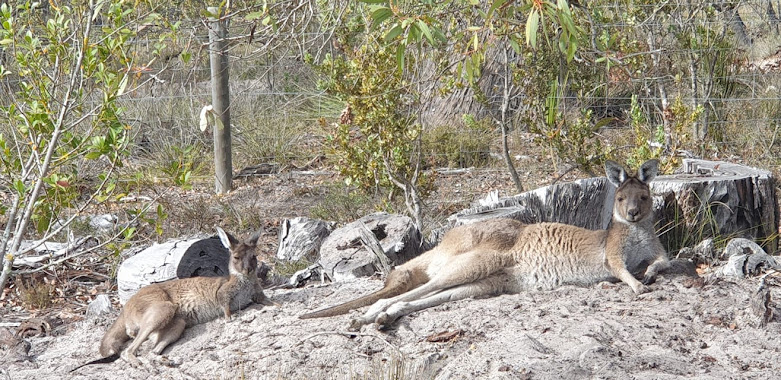Things I had to think about:
what specific issues/ threats will the project address.
activities the project will undertake to address the issues/ threats
What outcomes will be achieved at the end of the project?
Consider the risks to your project's success; what risks have you identified,
and what steps will you take to manage these risks?
How will your proposed activities benefit the local community and your organisation?
I had an idea of where to go with the first points but community involvement had be me a little stumped. Did I really want the community traipsing all over my property, interacting with the joeys that I am trying to rehabilitate to get ready for release?
After consultation with Sally from NRM in Perth I made contacts with local community organisations to seek their input, advice and support which ticked that box.
I now have letters of support from :-
Green Skills - Green Skills develops innovative projects that lead the way in sustainability and environmental conservation. A letter of support was received - benefit of linking Green Skills experience and knowledge, as well as projects such as the Balijup Fauna Sanctuary to the Amaris Wildlife Sanctuary. Basil who is the senior project manager visited Amaris and was excited to see the work being done here esp with the rehabilitation of our ring tail possums. He also took me on a guided tour of the Balijup Wildlife Sanctuary and it will be exciting to work with them as they have an amazing safe 220 acre feral proof sanctuary to release some of our precious wildlife.
Greenskills will also be able to provide advice and technical information for flora and fauna
identification and conservation and related matters to the Amaris Wildlife Sanctuary.
Oyster Harbour Catchment Group - Oyster Harbour Catchment Group are on the lookout for landholders to participate in property planning workshops to improve the condition and productivity of their property. They will be running a series of workshops to allow owners to map the characteristics and issues of their individual property, gain a better understanding of managing these issues and plan any proposed works. Well planned activities can achieve maximum benefits to both productivity and the environment. This is part of their looking back - looking forward initiative. As Amaris falls within this catchment area (just) They are excited to support my grant proposal and have offered to assist with the development of a property plan for Amaris
Shire of CranbrookCEO - have written a letter supporting Amaris Wildlife Sanctuary and offering support from Joe the ranger.
These 4 community groups are really excited to see the establishment of Amaris as a Wildlife Rehabilitation Sanctuary and are looking forward to working together.
Wildlife is important to the heritage, culture, and heart of Australia, and we want to preserve
it as a legacy for our children.
Every species plays a niche or role in its ecosystem that helps the whole ecosystem work.
Wildlife rehabilitation helps orphaned, injured and sick animals return to their ecosystems so
that they can continue to play their roles.
Wildlife rehabilitation is especially important for endangered species. There are very few of
these animals left, and wildlife rehabilitation can help make sure more survive to play their
role in the ecosystem.
Wildlife is everyone's responsibility, and deserves care from all people but Wildlife
rehabilitators are the ones that have been trained and been issued with a licence to provide
the care wild animals need when they becomes sick or injured.
Amaris has requested a grant for the installation of a water tank to use as an overflow tank for the current ones during the wet weather. Wildlife Cameras to monitor predators and pre release wildlife. Vegetation and restoration plan and the development of a property management plan.
Outcome of the project:
# Amaris Wildlife Sanctuary staff have the knowledge and ability to confidently manage day
to day operations relating to landcare and managing our natural resources
# Clear direction for Amaris Wildlife Sanctuaries future
# Amaris Wildlife Sanctuary to be known in the great southern community as the “transition
house” for our native animals
# Successfully release suitable rehabilitated animals to the nearby (10km away) Balijup
Wildlife Sanctuary which is managed by Greenskills
# Build a healthy ecosystem for wildlife on the Amaris Wildlife property
# providing wildlife with food and an environment, which closely resembles that of the wild.
# at certain times of the year it can be very difficult to find enough native foliage, so
growing on site will be beneficial
# providing plants, branches, floor leaf litter etc. that are important in making a suitable
environment for the animal/bird while in care. 'Familiar' habitat helps to lessen stress,
makes release an easier transition, and gives essential climbing, exercising, hiding and nest
building practice
# As the Critically Endangered Ringtail possums usually eat only the fresh tips of leaves it is
vitally important to have a variety of trees in different stages of growth to provide suitable
foilage.
This was a huge project and I was glad to finally hit the submit button. It was a very exciting time as well meeting the team at the various community groups and sharing my passion and vision for Amaris and receiving their support. They helped me identify the risks and steps to take to minimise that risk.
A HUGE thank you to Hilary and Freya at Gillami, Sayah at Oyster Harbour Catchment Group, Basil at Greenskills and Joe at shire of Cranbrook for your support in getting the grant over the line.









No comments:
Post a Comment